Natural language names
 | Wand - Standard |
 | Wall Standard Case |
 | Mur standard |
Change log
| DEPRECATED | This definition may be imported, but shall not be exported by applications. |
| Item | SPF | XML | Change | Description | IFC2x3 to IFC4 |
|---|---|---|---|---|
| IfcWallStandardCase | ||||
| OwnerHistory | MODIFIED | Instantiation changed to OPTIONAL. | ||
| PredefinedType | ADDED | IFC4x1 Release Candidate 3 | ||
| IfcWallStandardCase | MODIFIED | Status changed to Deprecated. |
Semantic definitions at the entity
Entity definition
The IfcWallStandardCase defines a wall with certain constraints for the provision of parameters and with certain constraints for the geometric representation. The IfcWallStandardCase handles all cases of walls, that are extruded vertically:
- along the positive z axis of the wall object coordinate system, and
- along the positve z axis of the global (world) coordinate system
and have a single thickness along the path for each wall layer, i.e.:
- parallel sides for straight walls
- co-centric sides for curved walls.
and have either:
- a straight line axis (straight wall), or
- a circular arc axis (round wall).
and shall not have
- aggregated components, that is, parts aggregated to a wall by IfcRelAggregates
- shape representation for 'Body' not being an extrusion, or clipped extrusion
The following parameter have to be provided:
- Wall height, taken from the depth of extrusion, provided by the geometric representation.
- Wall thickness, taken from the material layer set usage, attached to the wall
- Wall offset from axis, taken from the material layer set usage, attached to the wall
The IfcWallStandardCase requires the provision of the wall axis either a straight line that is parallel to the x-axis of the object coordinate system, or a circular arc where the tangent at start is parallel to the x-axis of the object coordinate system. The direction of the wall axis shall be the positive direction of that x-axis.
The material of the wall is defined by the IfcMaterialLayerSetUsage and is attached by the IfcRelAssociatesMaterial objectified relationship. It is accessible by the inverse HasAssociations relationship. The material layer set usage has to be given (enforced by where rule).
An 'Axis' and a 'Body' shape representation has to be provided, and it is invalid to exchange a 'Tessellation', 'SurfaceModel', 'Brep' or 'MappedRepresentation' representation for the 'Body' shape representation of the IfcWallStandardCase.
HISTORY New entity in IFC2x.
Formal Propositions
| Rule | Description |
|---|---|
| HasMaterialLayerSetUsage | A valid instance of IfcWallStandardCase relies on the provision of an IfcMaterialLayerSetUsage. |
Inherited definitions from supertypes
Entity inheritance
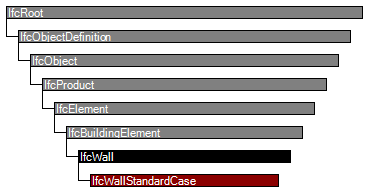
Attribute inheritance
| # | Attribute | Type | Cardinality | Description | G |
|---|---|---|---|---|---|
| IfcRoot | |||||
| 1 | GlobalId | IfcGloballyUniqueId | Assignment of a globally unique identifier within the entire software world. | X | |
| 2 | OwnerHistory | IfcOwnerHistory | ? |
Assignment of the information about the current ownership of that object, including owning actor, application, local identification and information captured about the recent changes of the object,
NOTE only the last modification in stored - either as addition, deletion or modification. IFC4 CHANGE The attribute has been changed to be OPTIONAL. | X |
| 3 | Name | IfcLabel | ? | Optional name for use by the participating software systems or users. For some subtypes of IfcRoot the insertion of the Name attribute may be required. This would be enforced by a where rule. | X |
| 4 | Description | IfcText | ? | Optional description, provided for exchanging informative comments. | X |
| IfcObjectDefinition | |||||
| HasAssignments | IfcRelAssigns @RelatedObjects | S[0:?] | Reference to the relationship objects, that assign (by an association relationship) other subtypes of IfcObject to this object instance. Examples are the association to products, processes, controls, resources or groups. | X | |
| Nests | IfcRelNests @RelatedObjects | S[0:1] | References to the decomposition relationship being a nesting. It determines that this object definition is a part within an ordered whole/part decomposition relationship. An object occurrence or type can only be part of a single decomposition (to allow hierarchical strutures only).
IFC4 CHANGE The inverse attribute datatype has been added and separated from Decomposes defined at IfcObjectDefinition. | X | |
| IsNestedBy | IfcRelNests @RelatingObject | S[0:?] | References to the decomposition relationship being a nesting. It determines that this object definition is the whole within an ordered whole/part decomposition relationship. An object or object type can be nested by several other objects (occurrences or types).
IFC4 CHANGE The inverse attribute datatype has been added and separated from IsDecomposedBy defined at IfcObjectDefinition. | X | |
| HasContext | IfcRelDeclares @RelatedDefinitions | S[0:1] | References to the context providing context information such as project unit or representation context. It should only be asserted for the uppermost non-spatial object.
IFC4 CHANGE The inverse attribute datatype has been added. | X | |
| IsDecomposedBy | IfcRelAggregates @RelatingObject | S[0:?] | References to the decomposition relationship being an aggregation. It determines that this object definition is whole within an unordered whole/part decomposition relationship. An object definitions can be aggregated by several other objects (occurrences or parts).
IFC4 CHANGE The inverse attribute datatype has been changed from the supertype IfcRelDecomposes to subtype IfcRelAggregates. | X | |
| Decomposes | IfcRelAggregates @RelatedObjects | S[0:1] | References to the decomposition relationship being an aggregation. It determines that this object definition is a part within an unordered whole/part decomposition relationship. An object definitions can only be part of a single decomposition (to allow hierarchical strutures only).
IFC4 CHANGE The inverse attribute datatype has been changed from the supertype IfcRelDecomposes to subtype IfcRelAggregates. | X | |
| HasAssociations | IfcRelAssociates @RelatedObjects | S[0:?] | Reference to the relationship objects, that associates external references or other resource definitions to the object.. Examples are the association to library, documentation or classification. | X | |
| IfcObject | |||||
| 5 | ObjectType | IfcLabel | ? |
The type denotes a particular type that indicates the object further. The use has to be established at the level of instantiable subtypes. In particular it holds the user defined type, if the enumeration of the attribute PredefinedType is set to USERDEFINED.
| X |
| IsDeclaredBy | IfcRelDefinesByObject @RelatedObjects | S[0:1] | Link to the relationship object pointing to the declaring object that provides the object definitions for this object occurrence. The declaring object has to be part of an object type decomposition. The associated IfcObject, or its subtypes, contains the specific information (as part of a type, or style, definition), that is common to all reflected instances of the declaring IfcObject, or its subtypes.
IFC4 CHANGE New inverse relationship, change made with upward compatibility for file based exchange. | X | |
| Declares | IfcRelDefinesByObject @RelatingObject | S[0:?] | Link to the relationship object pointing to the reflected object(s) that receives the object definitions. The reflected object has to be part of an object occurrence decomposition. The associated IfcObject, or its subtypes, provides the specific information (as part of a type, or style, definition), that is common to all reflected instances of the declaring IfcObject, or its subtypes.
IFC4 CHANGE New inverse relationship, change made with upward compatibility for file based exchange. | X | |
| IsTypedBy | IfcRelDefinesByType @RelatedObjects | S[0:1] | Set of relationships to the object type that provides the type definitions for this object occurrence. The then associated IfcTypeObject, or its subtypes, contains the specific information (or type, or style), that is common to all instances of IfcObject, or its subtypes, referring to the same type.
IFC4 CHANGE New inverse relationship, the link to IfcRelDefinesByType had previously be included in the inverse relationship IfcRelDefines. Change made with upward compatibility for file based exchange. | X | |
| IsDefinedBy | IfcRelDefinesByProperties @RelatedObjects | S[0:?] | Set of relationships to property set definitions attached to this object. Those statically or dynamically defined properties contain alphanumeric information content that further defines the object.
IFC4 CHANGE The data type has been changed from IfcRelDefines to IfcRelDefinesByProperties with upward compatibility for file based exchange. | X | |
| IfcProduct | |||||
| 6 | ObjectPlacement | IfcObjectPlacement | ? | Placement of the product in space, the placement can either be absolute (relative to the world coordinate system), relative (relative to the object placement of another product), or constraint (e.g. relative to grid axes). It is determined by the various subtypes of IfcObjectPlacement, which includes the axis placement information to determine the transformation for the object coordinate system. | X |
| 7 | Representation | IfcProductRepresentation | ? | Reference to the representations of the product, being either a representation (IfcProductRepresentation) or as a special case a shape representations (IfcProductDefinitionShape). The product definition shape provides for multiple geometric representations of the shape property of the object within the same object coordinate system, defined by the object placement. | X |
| ReferencedBy | IfcRelAssignsToProduct @RelatingProduct | S[0:?] | Reference to the IfcRelAssignsToProduct relationship, by which other products, processes, controls, resources or actors (as subtypes of IfcObjectDefinition) can be related to this product. | X | |
| IfcElement | |||||
| 8 | Tag | IfcIdentifier | ? | The tag (or label) identifier at the particular instance of a product, e.g. the serial number, or the position number. It is the identifier at the occurrence level. | X |
| FillsVoids | IfcRelFillsElement @RelatedBuildingElement | S[0:1] | Reference to the IfcRelFillsElement Relationship that puts the element as a filling into the opening created within another element. | X | |
| ConnectedTo | IfcRelConnectsElements @RelatingElement | S[0:?] | Reference to the element connection relationship. The relationship then refers to the other element to which this element is connected to. | X | |
| IsInterferedByElements | IfcRelInterferesElements @RelatedElement | S[0:?] | Reference to the interference relationship to indicate the element that is interfered. The relationship, if provided, indicates that this element has an interference with one or many other elements.
NOTE There is no indication of precedence between IsInterferedByElements and InterferesElements. IFC4 CHANGE New inverse relationship. | X | |
| InterferesElements | IfcRelInterferesElements @RelatingElement | S[0:?] | Reference to the interference relationship to indicate the element that interferes. The relationship, if provided, indicates that this element has an interference with one or many other elements.
NOTE There is no indication of precedence between IsInterferedByElements and InterferesElements. IFC4 CHANGE New inverse relationship. | X | |
| HasProjections | IfcRelProjectsElement @RelatingElement | S[0:?] | Projection relationship that adds a feature (using a Boolean union) to the IfcBuildingElement. | X | |
| ReferencedInStructures | IfcRelReferencedInSpatialStructure @RelatedElements | S[0:?] | Reference relationship to the spatial structure element, to which the element is additionally associated. This relationship may not be hierarchical, an element may be referenced by zero, one or many spatial structure elements.
IFC2x3 CHANGE The inverse attribute has been added with upward compatibility for file based exchange. | X | |
| HasOpenings | IfcRelVoidsElement @RelatingBuildingElement | S[0:?] | Reference to the IfcRelVoidsElement relationship that creates an opening in an element. An element can incorporate zero-to-many openings. For each opening, that voids the element, a new relationship IfcRelVoidsElement is generated. | X | |
| IsConnectionRealization | IfcRelConnectsWithRealizingElements @RealizingElements | S[0:?] | Reference to the connection relationship with realizing element. The relationship, if provided, assigns this element as the realizing element to the connection, which provides the physical manifestation of the connection relationship. | X | |
| ProvidesBoundaries | IfcRelSpaceBoundary @RelatedBuildingElement | S[0:?] | Reference to space boundaries by virtue of the objectified relationship IfcRelSpaceBoundary. It defines the concept of an element bounding spaces. | X | |
| ConnectedFrom | IfcRelConnectsElements @RelatedElement | S[0:?] | Reference to the element connection relationship. The relationship then refers to the other element that is connected to this element. | X | |
| ContainedInStructure | IfcRelContainedInSpatialStructure @RelatedElements | S[0:1] | Containment relationship to the spatial structure element, to which the element is primarily associated. This containment relationship has to be hierachical, i.e. an element may only be assigned directly to zero or one spatial structure. | X | |
| HasCoverings | IfcRelCoversBldgElements @RelatingBuildingElement | S[0:?] | Reference to IfcCovering by virtue of the objectified relationship IfcRelCoversBldgElement. It defines the concept of an element having coverings associated. | X | |
| IfcBuildingElement | |||||
| IfcWall | |||||
| 9 | PredefinedType | IfcWallTypeEnum | ? |
Predefined generic type for a wall that is specified in an enumeration. There may be a property set given specifically for the predefined types.
NOTE The PredefinedType shall only be used, if no IfcWallType is assigned, providing its own IfcWallType.PredefinedType. IFC4 CHANGE The attribute has been added at the end of the entity definition. | X |
| IfcWallStandardCase | |||||
Definitions applying to General Usage
Concept usage
Material Layer Set Usage
The Material Layer Set Usage concept applies to this entity.
Multi-layer walls can be represented by refering to several IfcMaterialLayer's within the IfcMaterialLayerSet that is referenced from the IfcMaterialLayerSetUsage.
Material information can also be given at the IfcWallType, defining the common attribute data for all occurrences of the same type. It is then accessible by the inverse IsDefinedBy relationship pointing to IfcSlabType.HasAssociations and via IfcRelAssociatesMaterial.RelatingMaterial.
The IfcWallType should then have a unique IfcMaterialLayerSet, that is referenced by the IfcMaterialLayerSetUsage assigned to all occurrences of this IfcWallType.
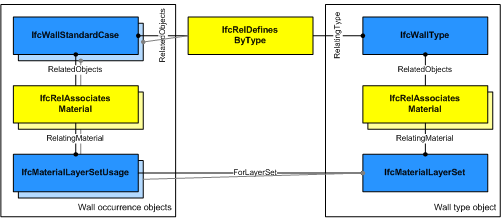 |
EXAMPLE Figure 258 illustrates assignment of IfcMaterialLayerSetUsage and IfcMaterialLayerSet to the wall type and the wall occurrence. |
Figure 258 — Wall Standard Object Typing |
Figure 259 illustrates material layer usage, where the following conventions shall be met:
- The reference coordinate system is the local coordinate system established by the ObjectPlacement of the IfcWallStandardCase.
- The reference axis is the axis defined by the IfcShapeRepresentation with RepresentationType='Axis' as one of the Representation.Representations of the IfcWallStandardCase.
- The IfcMaterialLayerSetUsage.OffsetFromReferenceLine is given as a distance from this axis.
- The IfcMaterialLayerSetUsage.OffsetFromReferenceLine is the distance parallel to the reference axis and always within the base (XY) plane of the reference coordinate system. A positve value of IfcMaterialLayerSetUsage.OffsetFromReferenceLine would then point into the positive y-axis of the reference coordinate system.
- The IfcMaterialLayerSetUsage.DirectionSense defines how the IfcMaterialLayer's are assigned to the reference axis. POSITIVE means in direction to the positive y-axis of the reference coordinate system.
- The Thickness of each IfcMaterialLayer is provided starting from the OffsetFromReferenceLine and in the direction given by DirectionSense. It is applied without any gap or overlap between two consecutive layers. The TotalThickness of the IfcMaterialLayerSet is the sum of all layer thicknesses.
- The IfcMaterialLayerSetUsage.LayerSetDirection is always AXIS2.
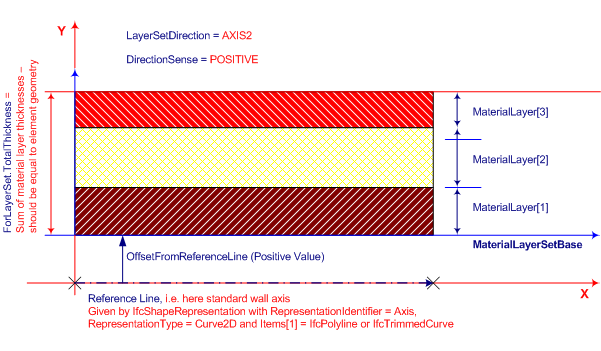 |
Figure 259 — Wall material layers |
Product Placement
The Product Local Placement concept template applies to this entity as shown in Table 192.
| ||||||
Table 192 — IfcWallStandardCase Product Local Placement |
The following restriction is imposed:
- The local placement shall provide the location and directions for the standard wall, the x/y plane is the plane for the profile, and the z-axis is the extrusion axis for the wall body.
Axis 2D Geometry
The Axis 2D Geometry concept template applies to this entity as shown in Table 193.
| ||||||||
Table 193 — IfcWallStandardCase Axis 2D Geometry |
The wall axis is represented by a two-dimensional open curve within a particular shape representation. The wall axis is used to apply the material layer set usage parameter to the wall geometry.
- Axis
- IfcPolyline having two Points, or IfcTrimmedCurve with BasisCurve of Type IfcLine for the 'SweptSolid' provided as IfcExtrudedAreaSolid. The axis curve lies on the x/y plane and is parallel to the x-axis of the object coordinate system.
- IfcTrimmedCurve with BasisCurve of Type IfcCircle for 'SweptSolid' provided as IfcExtrudedAreaSolid. The axis curve lies on the x/y plane of the object coordinate system, the tangent at the start is along the positive x-axis.
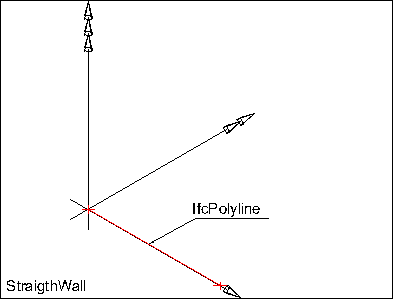 |
EXAMPLE Figure 260 illustrates an axis representation for a straight wall. In case of a straight wall, the set of items shall include a single geometric representation item of type IfcPolyline or IfcTrimmedCurve with the BasisCurve being an IfcLine. The IfcPolyline or IfcTrimmedCurve shall be parallel (here in a special case co-linear) to the x-axis of the object coordinate system. The direction shall be identical to the direction of the x-axis. |
Figure 260 — Wall axis straight |
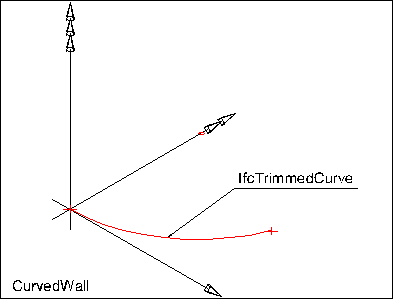 |
EXAMPLE Figure 261 illustrates an axis representation for a curved wall. In case of a curved wall, the set of items shall include a single geometric representation item of type IfcTrimmedCurve. The curve shall have a BasisCurve of type IfcCircle. The tangent of the IfcTrimmedCurve shall be parallel at start to the x-axis of the object coordinate system. The direction shall be identical to the direction of the x-axis. |
Figure 261 — Wall axis curved |
Body SweptSolid Geometry
The Body SweptSolid Geometry concept applies to this entity.
The following additional constraints apply to the 'SweptSolid' representation:
- Solid: IfcExtrudedAreaSolid is required,
- Profile: IfcArbitraryClosedProfileDef and IfcRectangleProfileDef shall be supported.
- Extrusion: The profile shall be extruded vertically, i.e., in the direction of the z-axis of the co-ordinate system of the referred spatial structure element. It might be further constraint to be in the direction of the global z-axis in implementers agreements. The extrusion axis shall be perpendicular to the swept profile, i.e. pointing into the direction of the z-axis of the Position of the IfcExtrudedAreaSolid.
The profile of a wall is described in the ground view and extruded vertically. The profile (also identical with the foot print of the wall) is defined by the IfcArbitraryClosedProfileDef (excluding its subtypes). The profile is given with all wall connections already resolved.
Figure 262 illustrates a body representation for a straight wall. In case of a straight wall, the two sides of the profile shall be parallel to the wall axis, that is, the wall has a single unchanged thickness.
Figure 263 illustrates a body representation for a curved wall. In case of a curved wall, the two sides of the profile shall be parallel (with defined offset) to the wall axis, that is, the wall has a single unchanged thickness.
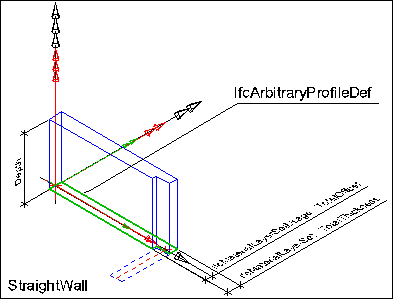 |
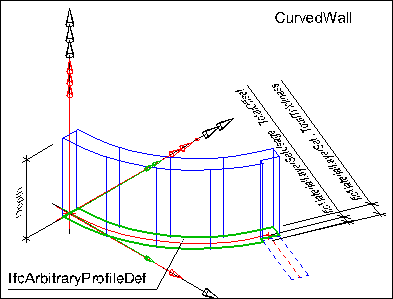 |
Figure 262 — Wall body extrusion straight |
Figure 263 — Wall body extrusion curved |
Body Clipping Geometry
The Body Clipping Geometry concept applies to this entity.
The following constraints apply to the 'Clipping' representation:
- Solid: see standard geometric representation
- Profile: see standard geometric representation
- Extrusion: see standard geometric representation
- Boolean result: The IfcBooleanClippingResult shall be supported, allowing for Boolean differences between the swept solid (here IfcExtrudedAreaSolid) and one or several IfcHalfSpaceSolid (or subtypes).
Figure 264 illustrates a clipping for a straight wall using an IfcPolygonalBoundedHalfSpace as SecondOperand in the IfcBooleanClippingResult.
Figure 265 illustrates a clipping for a curved wall using an IfcHalfSpaceSolid as SecondOperand in the IfcBooleanClippingResult.
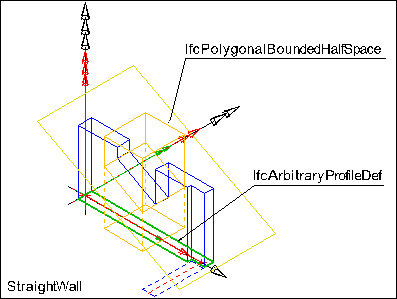 |
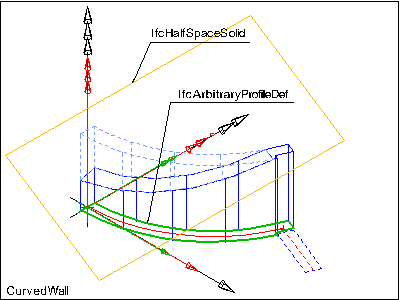 |
Figure 264 — Wall body clipping straight |
Figure 265 — Wall body clipping curved |
mvdXML Specification
<?xml version="1.0"?>
<ConceptRoot xmlns:xsi="http://www.w3.org/2001/XMLSchema-instance" xmlns:xsd="http://www.w3.org/2001/XMLSchema" uuid="828ef63f-7597-4566-bf20-af71d7f805da" name="IfcWallStandardCase" status="sample" applicableRootEntity="IfcWallStandardCase">
<Applicability uuid="00000000-0000-0000-0000-000000000000" status="sample">
<Template ref="fb896d52-87de-4fa4-98d7-28d845c4547f" />
<TemplateRules operator="and" />
</Applicability>
<Concepts>
<Concept uuid="0938757c-7015-4f80-b8e5-84249b860912" name="Material Layer Set Usage" status="sample" override="false">
<Template ref="6d5fb86f-3f2d-49fb-9528-077855ddcc47" />
</Concept>
<Concept uuid="95178cb6-bcc2-4138-88f8-e63b7ac32835" name="Product Placement" status="sample" override="false">
<Template ref="cbe85b5f-7912-4a43-8bb7-1e63bf40b26d" />
</Concept>
<Concept uuid="519873f2-d035-4df8-9f67-ce96049074e0" name="Axis 2D Geometry" status="sample" override="false">
<Template ref="782444e8-d681-475a-9034-a9e7f53c6d65" />
</Concept>
<Concept uuid="8437335e-7581-40d9-8d37-2e8a3579f9cd" name="Body SweptSolid Geometry" status="sample" override="false">
<Template ref="cb7c18fa-cf83-4db1-be1b-c013ba4ed672" />
</Concept>
<Concept uuid="5558384d-c5d1-43f1-91b6-ed21ba000e4b" name="Body Clipping Geometry" status="sample" override="false">
<Template ref="2cdbc2f5-9b0c-43ea-9d2a-9d72d0147e00" />
</Concept>
</Concepts>
</ConceptRoot>
Concept inheritance
Examples
Formal representations
XML Specification
<xs:element name="IfcWallStandardCase" type="ifc:IfcWallStandardCase" substitutionGroup="ifc:IfcWall" nillable="true"/>
<xs:complexType name="IfcWallStandardCase">
<xs:complexContent>
<xs:extension base="ifc:IfcWall"/>
</xs:complexContent>
</xs:complexType>
EXPRESS Specification
ENTITY IfcWallStandardCase
SUBTYPE OF (IfcWall);
WHERE
HasMaterialLayerSetUsage : SIZEOF (QUERY(temp <* USEDIN(SELF, 'IFCKERNEL.IfcRelAssociates.RELATEDOBJECTS') |
('IFCPRODUCTEXTENSION.IfcRelAssociatesMaterial' IN TYPEOF(temp)) AND
('IFCMATERIALRESOURCE.IfcMaterialLayerSetUsage' IN TYPEOF(temp.RelatingMaterial))
)) = 1;
END_ENTITY;

 Instance diagram
Instance diagram Link to this page
Link to this page